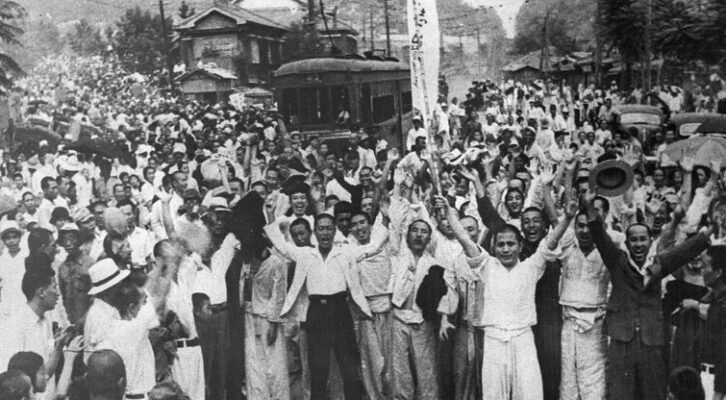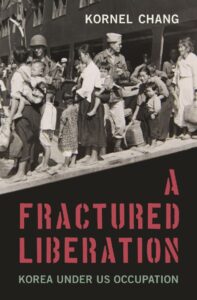
No North, No South: The Tragically Unfulfilled Promise of Korea’s Asian Spring
From Kornel Chang’s Cundill Prize-Shortlisted “A Fractured Liberation”
The collapse of the Japanese empire ushered in an extraordinary—indeed, a once in a lifetime—opportunity for Koreans. After nearly forty years of foreign rule, this was their chance to start over. It kindled hopes of what a future Korea could be: freer, better, and more equal and just. The electrifying sense of possibility jolted Koreans into action. Peasants occupied Japanese-owned farmlands, workers seized control of the factory floor, villagers chased the former colonial police out of town, and women demanded political and economic equality. The explosion of activities made it seem as if Koreans had readied for this moment their whole lives.
The countless initiatives that surfaced after August 15 were seeded during the dark years of the colonial period. Japanese rule spawned Korean struggles for independence, both at home and abroad, beginning with the 1919 March First Movement, which saw two million Koreans participate in nationwide protests against colonial rule. (My great-grand uncle was arrested and imprisoned for reading aloud the Declaration of Korean Independence during the March First Movement.) Nationalists of various political stripes organized the Korean Provisional Government—Korea’s government in exile— in Shanghai, after Japanese authorities had violently put down the protests.
As much as Koreans wanted to imagine independence as a brand-new start—a tabula rasa, if you will—the colonial past threatened to haunt the liberatory present.
The colonial years also witnessed the explosive growth of communism and socialism in Korea’s cities and countryside. Preaching the gospel of revolution, activists mobilized peasants and workers (and to a lesser degree, women) to rebel against inequality and exploitation. “Our national emancipation movement is merely a step toward the ultimate purpose of social revolution,” their manifesto declared. “This is our belief and the common objective of all the toiling masses of the world.” Their calls for land redistribution, workers’ rights, and women’s equality were among the core demands for independence after the fall of the Japanese empire.
At the same time, Japanese rule sowed new divisions and exacerbated old ones among Koreans. Colonial repression and factionalism divided nationalists and left them fighting bitterly over who were the true heirs to the March First Movement. Communists and socialists bickered over doctrine and orthodoxy. And rank-and-file workers and peasants pursued their own goals that put them at odds with activists and their agendas. The divide between the Korean landed elite and the peasant masses that predated Japanese rule grew deeper and more complex as a result of colonial policies.
Japanese rule also established new fault lines within Korean society by furnishing political and economic opportunities for some of their colonial subjects. This included prominent businessmen, landowners, poets, novelists, and local officials who were detested for abetting Japanese rule. Coming to terms with colonial-era collaboration would pose one of the most vexing challenges in a liberated Korea. As much as Koreans wanted to imagine independence as a brand-new start—a tabula rasa, if you will—the colonial past threatened to haunt the liberatory present. These divides ensured that when Koreans emerged out of colonialism, they would not share a single, pristine vision of independence. The meaning of liberation would have to be worked out, perhaps even fought over. The great uncertainty around what would come next worried Koreans like Kang, who wondered, “What would this country become in the coming future?” He remembered the question consuming him, as the exhilaration of liberation gave way to anxiety over an unknown future.
Could Koreans rise above their differences to rebuild their nation? Could they make the transition to independence without spiraling into chaos and violence? Using both carrot and stick, Japanese colonial rule had kept a lid on both Korean aspirations and conflicts—that is, until August 15, 1945. With the sudden collapse of the Japanese empire, hopes, visions, and fractures that had been bottled up for nearly forty years erupted into Korea’s Asian Spring. If Koreans deserved anything after nearly four decades of colonial rule, it was the chance to determine their own futures.
*
The blooming of Korea’s Asian Spring was cut short by the arrival of foreign occupying armies. Shortly after Japan’s surrender, US and Soviet officials agreed to establish two military occupation zones, one in the South run by the Americans and the other in the North directed by the Russians. The US occupation government, led by Lieutenant General John R. Hodge, carried out a hard-line, anti-communist agenda that largely preserved the pre-liberation status quo below the 38th parallel. This involved, among other things, reconstituting the hated colonial police and rolling back the changes that had been initiated by Koreans during the three-and half-week interlude between Japan’s surrender and the arrival of American forces. In contrast to postwar Japan, where Americans, according to historian John Dower, “proceeded to dismantle the oppressive control of the imperial state,” the US occupation in Korea maintained much of the colonial system and dealt with Koreans with a heavy hand. In one of the great ironies of the immediate postwar, Japan, the hated wartime enemy, received democratization and reform, while Korea, a liberated country, got the hard line and discipline.
Following this storyline, most accounts of Korea just after World War II look at these years for the origins of the Korean War. Highlighting the forces of repression and polarization, scholars show the United States adopting a “reverse course” policy—to create an anti-communist bulwark in the South—from the very outset in Korea. The Cold War looms large: the partition of Korea in August 1945 becomes the “first postwar act of containment,” and General Hodge, the leader of the US occupation, a “premature Cold War warrior.” The decisions of Hodge and his military high command, these accounts suggest, entrenched divisions among Koreans and made reunification virtually impossible. The result: an inexorable march to war.
There are good reasons for seeing postwar Korea in this way. The Cold War continues to rage on the Korean peninsula after all—seventy-five years and counting—as an anachronism that refuses to die. But was the occupation period only a prelude to the Korean War? Did all roads have to lead to schism and war? The haste to get to the Cold War has sidelined Korea’s Asian Spring to the margins of history. As a drama moving relentlessly toward division and war, the actions of the great powers—especially of the United States—occupy center stage. They have left little room for the voices and struggles of Koreans and the possibility that things could have turned out differently. Even in the few cases in which Korean experiences are considered, they are typically captured in binary terms: communism versus capitalism, left versus right, and revolutionary versus reactionary. Viewing their actions and ideas strictly through a Cold War lens has oversimplified Korean hopes and ambitions and flattened the complexity of their post-liberation experience.
*
This book is meant to capture a moment alive with promise and possibility, when Koreans were seized by dreams of freedom and starting anew. It looks at what Koreans at all levels of society in the South—from political leaders and activists to ordinary peasants, workers, and women—aspired to, at the independence they envisioned, and at how they sought to make it a reality. My book also reveals the tensions and clashes that arose as Koreans pursued their diverse goals for liberation. Watchwords like “revolution,” “freedom,” and “independence” meant different things to different people—they were moving targets that inspired a wide range of initiatives and ideas. This singular opportunity to work out the meaning of independence both inspired and divided Koreans, giving rise to a kaleidoscopic post-liberation experience.
The ongoing, seemingly endless, conflict on the peninsula makes it hard to imagine Korea beyond North and South. But this is not the way it had to be. Koreans pursued alternative visions for their country. In fact, the choice Koreans faced at the end of 1948, between a one-party communist state and an autocratic liberalism, was between two options that had very little support at the beginning of the occupation. Between the two extremes was a social democratic majority that demanded a more egalitarian society without necessarily calling for a revolution.
Virtually all Koreans wanted land redistribution, labor rights, and a reckoning with their collaborationist past. But most Koreans, not being strict idealogues (many of them were not aware of what political labels meant), were not rigidly dogmatic about how to achieve these goals, nor were they against compromise or cooperation. After liberation, many of them pursued incremental changes to improve their daily lives. Tenant farmers secured long-term leases or bought land at a steep discount from their landlords. Workers demanded and received higher wages and better working conditions. Women negotiated nursing at work and maternity leave. And the most popular refrain among workers at the time was “Capitalists will sacrifice their money, technicians their skills, and workers their efforts for reindustrialization.” This also applied to a good number of activists, who adopted a pragmatic, even cautious approach to liberation, especially once they learned that the United States would be occupying the South. That is to say, it was not revolution or nothing for most Koreans. As sprawling and contentious as Korea’s Asian Spring was, it had a social democratic spine running through it.
I seek to restore contingency to a narrative that looks ahead to division and war as an inevitable endpoint: North and South is not the way it had to be.
What is more, the core aspirations of the Korean majority had the backing of American and Korean reformers in the military government, who had been sent to Korea by the State Department. They included New Deal liberals, Christian socialists, and trade unionists who challenged Hodge’s hard-line, anti-communist approach. They proposed land redistribution, New Deal-style trade unionism, and voting rights, and advocated removing collaborators from public life. Despite the high command’s efforts to reduce Korean aspirations to Cold War binaries, these reformers knew that their ambitions were broader and more diverse. Their stories reveal the paths not taken. In telling them, I seek to restore contingency to a narrative that looks ahead to division and war as an inevitable endpoint: North and South is not the way it had to be.
This then begs the question, If there was a majority of Koreans who wanted social democratic style reforms, and their aspirations had the support of American and Korean reformers in the military government, why did South Korea end up with an authoritarian regime led by Syngman Rhee? Historians have pointed to Hodge’s early support of reactionary rightists, including industrialists, landlords, and businessmen—people who were associated with Japanese rule. As Bruce Cumings has argued, “The Occupation made critical choices in the last months of 1945 that shaped the conditions in which a rightist autocracy could emerge triumphant more than two years later.” There is no doubt that these early decisions contributed to the tragic outcome in the South and Korea more broadly. However, they did not seal Korea’s fate: there was still time and opportunity for Americans to shift course.
It wasn’t very long before Hodge himself recognized the error of backing Rhee. In the summer of 1946, he authorized talks with moderate leftists and rightists to create a “true coalition of democratic parties,” leaving the Far Right and Left outside looking in. With Hodge’s support, liberal advisers thought a third way was a genuine possibility. Carving a path between North and South would not be easy—there were challenges, for sure. US policymakers had to contend with Korean expectations, Soviet competition, and Rhee’s constant brinkmanship. But just because it was hard doesn’t mean things had to turn out the way they did.
My book highlights the key moments, where a different choice, firmer resolve, and a twist or turn in favor of unity, could have led to alternative outcomes. I also explain how and why these key moments became missed opportunities. Each failure had a compounding effect, leaving policymakers with fewer and fewer good options, until there was none. By the fall of 1947, a palpable sense of resignation and gloom had settled over the American Occupation, with one State Department official remarking, “Whatever we do now in Korea is bound to be bad. Our only hope is not to do worse.” These bad and worse policy options were made stark in a top-secret State-War-Navy Department memo: “The United States is obliged to decide whether it will continue to occupy South Korea for an indefinite period, or whether it will withdraw and permit the Soviet Union to dominate the entire peninsula….If the US determines that its interests will be better served by remaining in Korea, it will have to face up to the responsibility it is assuming in regard to the Korean people.”
__________________________________

From A Fractured Liberation: Korea Under US Occupation by Kornel Chang. Copyright © 2025. Available from Belknap Press, an imprint of Harvard University Press. A Fractured Liberation was shortlisted for the Cundill History Prize.
Kornel Chang
Kornel Chang is the author of Pacific Connections: The Making of the U.S.-Canadian Borderlands, winner of the Association for Asian American Studies Book Prize in History. He is Professor of History and Chair of the History Department at Rutgers University–Newark.



















